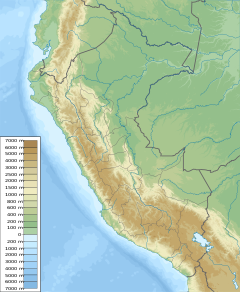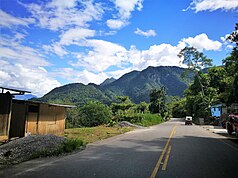Tingo María National Park
| Tingo María National Park | ||
|---|---|---|
| Entrance to the Las Lechuzas cave | ||
|
|
||
| Location: | Huánuco , Peru | |
| Surface: | 47.778 km² | |
| Founding: | May 14, 1965 | |
| Entrance sign at the park | ||
| La Bella Durmiente | ||
The National Park Tingo María (span .: Parque Nacional Tingo María ) is on May 14 in 1965 by the law Ley Nº 15574 National Park was established in the districts of Mariano Damaso Beraun and Rupa-Rupa of the province of Leoncio Prado in Huánuco in Peru .
location
The park boundary is in the east of the Río Huallaga , in the north of the Río Monzón , in the west of the Cerro Blanco with the stream Río Oro, and in the south the valley of the Río Santa. The area is characterized by a mountain range called La Bella Durmiente , the sleeping beauty . Another geological characteristic of the park is the so-called Cueva de las Lechuzas ("Cave of the Owls"), although the birds that live there are not owls but fat swallows ( Steatornis caripensis ). The park entrance is about 6.5 kilometers from Tingo María .
Flora and fauna
The biological diversity is enormous with numerous species.
Mammals
Among the species of mammals in the park are Flachlandtapir ( Tapirus terrestris Linnaeus , 1758) Red Brocket ( Mazama americana ( Erxleben , 1777)), collared peccary ( Pecari tajacu ( Linnaeus , 1758)), ocelot ( Leopardus pardalis ( Linnaeus , 1758)), Bolivian squirrel monkey ( Saimiri boliviensis I. Geoffroy Saint-Hilaire & Blainville , 1834) and brown-backed tamarin ( Leontocebus fuscicollis ( Spix , 1823)) native. Moreover, in the Park Andean Nachtaffe ( Aotus miconax Thomas , 1927), Black face monkey ( Ateles chamek ( Humboldt , 1812)) and Pacarana (Dinomys branickii Peters , 1873), tube lip long proboscis bat ( Anoura fistulata Muchhala , Mena-Valenzuela & Albuja , 2005) Andersen fruit vampire ( Artibeus anderseni Osgood , 1916), Salvin's bigeye bat ( Chiroderma salvini Dobson , 1878), leaf-nosed bat ( Lophostoma silvicolum ( d'Orbigny , 1836)) and Micronycteris hirsuta ( Peters , 1869) detected.
Birds
The Andean rock cock ( Rupicola peruvianus ( Latham , 1790)), king vulture ( Sarcoramphus papa ( Linnaeus , 1758)), Amazonasmotmot ( Momotus momota ( Linnaeus , 1766)) are among the at least 178 bird species that live in the park . In addition, fat schwalm ( Steatornis caripensis von Humboldt , 1817) and black-bellied tangar ( Ramphocelus melanogaster ( Swainson , 1838)) can also be found in the park.
plants
The flora is typical of high forest, which is characterized by moist cloud forest at altitudes around 1800 meters. The forest is stunted in many areas. The trees are covered by plants, mosses and ferns due to the moisture. You can find Brazilian cedar ( Cedrela fissilis ), the mimosa family Cedrelinga cateniformis , the laurel family Ocotea longifolia or the red family Calycophyllum multiflorum . June to December is the best time to discover medicinal plants and orchids.
climate
The rainy season is from October to April. During this time the park is only accessible to a limited extent. The average annual temperature is 24.5 ° C.
literature
- Biosfera Consultores Ambientales SAC: Informe: Evaluación de Flora y Fauna del Parque Nacional Tingo María . Empresa de Generación Huallaga SA, San Isidro - Lima 2015 ( siar.regionhuanuco.gob.pe [PDF; 5,7 MB ]).
Web links
Individual evidence
- ↑ LEY Nº 15574 - Parque Nacional Tingo Maria (span.)
- ↑ a b c d e Tingo María at Sernap
- ↑ Biosfera Consultores Ambientales SAC, p. 20.
- ↑ BirdLife Important Bird and Biodiversity Areas - Parque Nacional Tingo María



